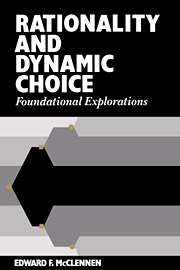Book contents
- Frontmatter
- Contents
- Conditions on orderings and acceptable-set functions
- Acknowledgments
- 1 Introduction and sketch of the main argument
- 2 The ordering principle
- 3 The independence principle
- 4 The problem of justification
- 5 Pragmatic arguments
- 6 Dynamic choice problems
- 7 Rationality conditions on dynamic choice
- 8 Consequentialist constructions
- 9 Reinterpreting dynamic consistency
- 10 A critique of the pragmatic arguments
- 11 Formalizing a pragmatic perspective
- 12 The feasibility of resolute choice
- 13 Connections
- 14 Conclusions
- 15 Postscript: projections
- Notes
- Bibliography
- Author index
- Subject index
6 - Dynamic choice problems
Published online by Cambridge University Press: 05 February 2012
- Frontmatter
- Contents
- Conditions on orderings and acceptable-set functions
- Acknowledgments
- 1 Introduction and sketch of the main argument
- 2 The ordering principle
- 3 The independence principle
- 4 The problem of justification
- 5 Pragmatic arguments
- 6 Dynamic choice problems
- 7 Rationality conditions on dynamic choice
- 8 Consequentialist constructions
- 9 Reinterpreting dynamic consistency
- 10 A critique of the pragmatic arguments
- 11 Formalizing a pragmatic perspective
- 12 The feasibility of resolute choice
- 13 Connections
- 14 Conclusions
- 15 Postscript: projections
- Notes
- Bibliography
- Author index
- Subject index
Summary
Dynamic choice and decision trees
In very general terms, a dynamic choice problem can be characterized as one in which the agent is called upon to make a sequence of choices over time, in response to situations that are a function of his own earlier choices and (perhaps also) certain randomly determined events. The classic representation of such a problem is that of a “decision tree,” with branch points defining either choices to be made by the agent or possible outcomes of chance events determined by nature (Figure 6.1). By convention, choice branches (n0, n2) are designated by squares; chance branches (n1) by circles. A particular sequence of choice and/or chance events takes the agent from the initial node or branch point (n0) in the tree to some terminal node or outcome of the tree (o1, o2, etc.). For example, if the agent elects to take the upper branch at n0, then chance events (to which determinate probabilities may or may not be assignable) determine whether he ends up at n2 with another choice to be made, between s(n2) – the branch leading to outcome o1 – and r(n2) – the branch leading to outcome o2 or whether he ends up simply confronting the outcome o3.
Such a representation, of course, involves what some will regard as an arbitrary conceptual cut.
- Type
- Chapter
- Information
- Rationality and Dynamic ChoiceFoundational Explorations, pp. 99 - 111Publisher: Cambridge University PressPrint publication year: 1990



